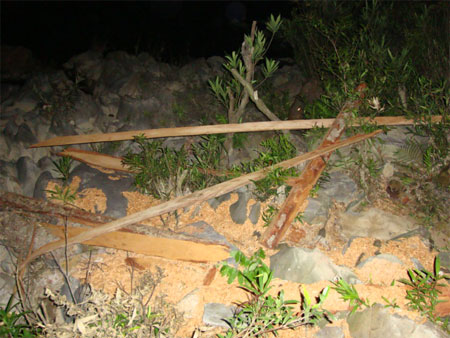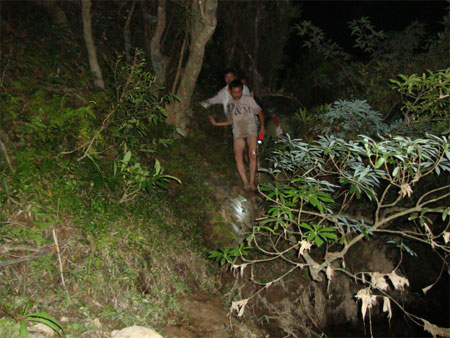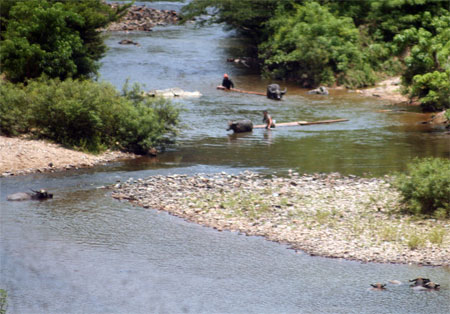Khe Net's forest destruction is happening at an alarming state, despite its consideration as a Nature Reserve. The area is a part of Tuyen Hoa protective forest in Quang Binh Province. With the help of an informant, DTiNews reporters went on a quest in search of some answers.
Attempts in catching the big fish
 |
| Traces of timber left behind by poachers on the way to Ba Lang. |
As promised, one afternoon in late May, our informant (previously a well-known timber poacher in the region of Khe Net - Tan Ap) called and dropped some big news on us: three large timber rafts, estimated to be dozens of cubic metres in volume were being kept in Ba Lang, the upper region of Khe Net. By foot, the distance is about 30 minutes away from Khe Net forest protection station (Tuyen Hoa Protective Forest Management Board).
"Within the night or by tomorrow morning, the whole transportation process will have been completed. If you can get there tonight, there may be a chance for you to catch them in action. Once the logs have been brought to the other side of Khe Net Bridge, there would be no hope at all," the informant shared and confirmed his information source's credibility by supplying us a full name list of the timber poachers who were to be involved.
Shortly after the call, we set off and arrived in Khe Net after about 115 kilometres of travelling through dusty roads (due to construction). By the time we got there, the night had fallen.
On our way to Ba Lang, several buffalo wheeled carts heavily loaded with timber struck our eyes. The buffaloes, the carts and the timber went on without cover. In the section stretching from Do Vang Bridge to Tan Ap, there were about 3 to 4 of those carts and dozens of stout buffaloes pulling carts of timber.
At the sight, we felt like calling the forest police to come and arrest these illegal wood traders and there was no need for us to go any further. However, our informant resolutely dissuaded our thoughts and said to us impatiently, "If you want to catch the big fish, you gotta be willing to go for the whole distance."
 |
| Slippery pathways make it difficult for us to navigate. |
Feeling disappointed, we continued on the road until we reached Khe Net Bridge. The forest protection station was positioned right on the edge of the river bank, exactly as our informant promised. It was obvious that no timber was to pass through without being noticed by the forest protection team stationed here. After a quick discussion on Khe Net Bridge, we decided that it would be too dangerous and feeble for us, unarmed journalists, to go on and catch the thieves without any kind of assistance.
Recently, there have been several cases where timber poachers fought strongly against duty officers in Quang Binh. Our intermediary had also warned us that if the amount of timber has been taken to Ba Lang, they, the timber poachers will not easily give up. We decided to take up another plan, contacting the Environmental Police (PC36 - Province's Police).
After only half an hour, 4 undercover environmental police appeared and their presence reassured us to go on. The road was completely dark with only a few scattered lights from people's houses and mine ore projected onto us from afar.
When we arrived at the forest protection station, Luong Ngoc Van, head of the team and the other team members having just finished their meal, enthusiastically agreed to help us.
The whole group went past the rubber tree plantation and walked along the bank toward the upper part of the stream. Due to the fact that we were in treacherous terrain, the forest protection team volunteered to lead us through.
 |
| In order to reach Ba Lang, the group has to either bend their back or lean againts a stick to prevent slipping accidents from occuring. |
"Just keep going, the timber logs, once having been connected into rafts, can only drift downstream," our informant assured us in his last call at 9 pm.
After about almost an hour of searching, the reportedly "three large timber rafts" were still nowhere to be seen. During our quest, we tripped over and got soaking wet countless times because of slippery rocks in the area. "We must have been misled," someone spoke. I quietly stepped behind and tried to get in touch with our informant, but there was no response.
Another 30 minutes in search only brought us disappointment. We decided to leave the area and offered our apology to the environmental police who accompanied us. Kind and encouraging words were offered to us in return, "This is not uncommon. We understand. When intermediaries are unable to follow the poachers, the situation can be turned around so fast that it is beyond anyone's control."
We turned back, arrived at the forest protection managament and unable to control our thirst, we drank the tea given by the head of the forest protection team in quick gulps. He further affirmed that our source of information was not trustworthy, "There is no way the timber poachers would have their timber rafts drifting through the river here. Our control in this area is very tight. It is just impossible!"
Efforts repaid
Early in the morning the following day, we received a call from our informant. He did not explain why he was out of reach when we tried to contact him, but simply sneered at us, "By the time you arrived in Ba Lang, they had already been able to transport the timber logs to the riverhead and let the timber rafts drift down Gianh River. My facts could not be wrong!" When we showed him signs of doubt over the information he had just given us, he replied with anger, "You just wait and see!"
After waiting for another 2 days, finally, we were contacted by our informant again. He said the amount of timber being transported this time was slightly less in number, but this timber load was to be transported in broad daylight. We left hurriedly, but did not dare contact the environmental police for fear of another prank.
 |
| Buffaloes pulling wood logs behind as viewed from Khe Net forest protection station. |
It was the same road that we had travelled on, but our approach this time had changed. Passing through Khe Net forest protection station, we briefly stopped and talked about some environmental issues in regards to nearby mine ores with the forest protection team before continuing. After a turn, we secretly came back to where the station was, found a place to hide under Khe Net Bridge and waited.
After 30 minutes of waiting in scorching hot weather, we started to spot a buffalo pulling behind it timber logs that had been pared into square logs. Another suspicious buffalo appeared, and then one after another. Not wanting to waste a minute, we started shooting photos immediately and captured images of the buffaloes as well as the stampede of the timber poachers when they caught glimpse of us.
We returned to the station and informed the forest proctection team that the illegal cut amount of timber has been making its way down the river and was almost here. "No, that can't be. We are still sitting here," Van reassured us decidedly, exactly like how he did the other night.
However, while Van was trying to convince us, that it couldn't be happening right there, behind his back, down the shallow waters, groups of people and buffaloes were walking through. Van went silent for a few seconds before he realised what was happening and ordered his staff to get to the riverside.
Before we made a move, Van quickly grabbed us and explained reasons for his mistake, "Please understand. The fish get through when the water gets through. It is our fault that we were so careless. The poachers have taken advantage of us."
Two hours later, when we stepped inside the office of Nguyen Hoai Nam, Director of Tuyen Hoa Protective Forest Management Board, Van was already there before us. "That's Van from the Khe Net forest protection station. He came to report to us about the illegal timber transportation. He asked me which newspaper you work for," Nam said in a straightforward manner.
After hearing a complete recount of what happened, Nam assured us he will hand out proper discplinary actions for the Khe Net station team. Our conversation was interrupted for a few minutes by the call of our informant who said, "See! I told you so!"
The "three-large-timber-raft" case might never be clarified, but pictures of buffalo wheeling carts carrying logs of wood freely on the road, buffaloes pulling wooden logs right in plain sight of the forest protection team and the badly explained reasons of the head of the team, provide enough evidence for the extreme forest destruction that needs to be addressed and is such a contrast paradox to preservating a forest that won't have much left to be preserved if action isn't taken soon.

Leave your comment on this story